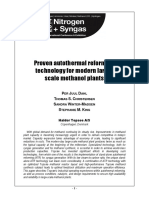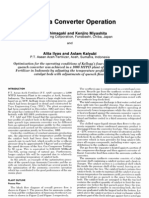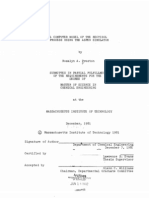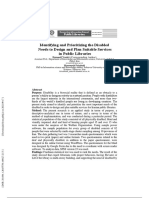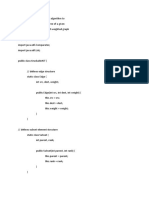Advanced Gas-Heated Reformer: P. W. Farneil
Advanced Gas-Heated Reformer: P. W. Farneil
Uploaded by
Alfonso BlancoOriginal Description:
Original Title
Copyright
Available Formats
Share this document
Did you find this document useful?
Is this content inappropriate?
Report this DocumentCopyright:
Available Formats
Advanced Gas-Heated Reformer: P. W. Farneil
Advanced Gas-Heated Reformer: P. W. Farneil
Uploaded by
Alfonso BlancoCopyright:
Available Formats
Advanced Gas-Heated Reformer
Based upon extensive experience in the design and operation of certain Gas-Heated Reformers
(GHRs), a modified design of the GHR known as the Advanced GHR has been developed. The AGHR
has been based upon the successful features of the GHR, as proven over the past 10 years with the
introduction of several new features that offer improved benefits to the operator of the novel
technology over conventional technology. After more than one year of successful operation, the
AGHR is viewed as being commercially proven.
P. W. Farneil
Synetix, Billingham, England
introduction mentally the plant energy balance, in that involuntary
steam generation is markedly reduced, giving flexibili-
ty at the design stage in the way in which the plant
I
n 1988 ICI commissioned two Leading Concept
Ammonia plants at its Sevemside site in England. power and steam requirements are met. The reformer
This was followed in 1994 when BHP Petroleum used in these LCA and LCM plants is a compact
commissioned its Methanol Research Plant using reformer similar to a shell-and-tube heat exchanger,
Synetix's Leading Concept Methanol process near known as the Gas Heated Reformer (GHR). To date,
Melbourne, Australia. The most recent plant utilizing ICI has presented several technical papers on the GHR
Synetix's novel reforming technology is the LCA plant itself, and the LCA and LCM processes (Elkins et al,
operated by Mississippi Chemicals in Yazoo City, MS. 1991; Armitage et al., 1992; Farnell, 1996).
The original LCA plants were the first real significant During the operation of the current LCA and LCM
change in both ammonia and methanol process tech- plants, and also during design studies for world-scale
nology since the introduction of the large single plants, a revised design of the GHR has been devel-
stream, energy integrated designs of the 1960s. Both oped which is known as the Advanced Gas Heated
of the plants incorporate many innovative features in Reformer (AGHR). The design of the AGHR has
their process design, catalytic reactor design, and con- many features in common with the original design of
trol. GHR, but differs in the key respect that it uses a single
The most fundamental area of innovation is in the pass tube arrangement, unlike the original design
primary reforming area, where the recycling of heat which is a bayonet tube reformer.
from the secondary reformer effluent gas into primary The change to the AGHR design results in a
reforming completely alters the plant design, as well reformer which is of lower cost, easier to operate, eas-
as the plant layout and operation. It changes funda- ier to fabricate, and allows scale-up to in excess of
AMMONIA TECHNICAL MANUAL 173 2000
current world-scale methanol plant throughputs. as boiling, feedstock preheat, or distillation reboil.
Furthermore, the reformer is more robust in operation The fundamental difference is that, in the series
and is easier to maintain. This article reviews the scheme, all of the feed gas is reformed to high temper-
development of the AGHR, and compares the AGHR ature in the secondary reformer, resulting in higher
to the original design of the GHR and other heat methane conversion and a low methane slip. The par-
exchange reformers. allel scheme reforms some of the methane in the heat
exchange reformer alone to a lower temperature,
Heat Exchange Reforming Schemes resulting in a higher methane slip and a lower methane
conversion. The benefit of the parallel scheme is that it
When considering the use of heat exchange reform- requires a simpler reformer design, with a single
ing for the production of synthesis gas, there are two tubesheet and open-ended tubes.
available and demonstrated process flow schemes. The Once the process is developed further, it is found
first is the series scheme as given in Figure 1 and the that the parallel scheme suffers from a reduced ther-
parallel scheme as given in Figure 2. mal efficiency compared to the series scheme. In order
In the series scheme, the natural gas and steam that the methane slip in the parallel scheme is reduced,
mixed feed is preheated to the heat exchange reformer the heat exchange reformer is required to operate at
inlet temperature, and all of the mixed feed is fed to higher temperatures, which requires the flow through
the tubeside inlet. This is reformed and then fed to the the tubeside to be only 25% of the total syngas flow.
secondary reformer, where oxidant is added to Due to the flow imbalance, the amount of heat that can
increase the temperature and complete the methane be transferred into the small tubeside flow is less than
reforming. The synthesis gas produced in the sec- in the series scheme where all of the mixed feed pass-
ondary reformer then flows through the shellside of es through the tubeside. Additionally, the heating
the heat exchange reformer, which cast loose a sub- medium on the shellside of the heat exchange reformer
stantial portion of its thermal energy. The gas then is a mixture of the hot secondary reformer product
flows from the shellside of the heat exchange reformer mixed with the cooler tubeside product. This results in
and gives up further heat in other heat recovery duties a lower temperature of the heating medium, again
such as boiling, feedstock preheat, or distillation decreasing the amount of heat that can be recovered.
reboil. Therefore, to close the heat balance in the parallel
In the parallel scheme, the natural gas and steam scheme, more hydrocarbon and oxygen are burned in
mixed feed are preheated in a fired preheater. The the secondary reformer than in the case of the series
mixed feed is then split into two parallel streams, with scheme.
about 25% being fed to the heat exchange reformer
and 75% to the secondary reformer. The feed to the Synetix's Gas Heated Reformer
tubeside of the heat exchange reformer is reformed as
it flows down the tubes and then exits at the bottom of Given that the choice of heat exchange reforming
the tubes directly into the shellside. The mixed feed scheme is the series scheme, a heat exchanger needs to
flowing to the secondary reformer is burned with an be designed which maintains the tubeside and shell-
oxidant to raise the temperature and complete the side fluid as totally separate streams. This could be
methane reforming. The synthesis gas produced in the achieved with a conventional heat exchanger arrange-
secondary reformer flows into the shellside of the heat ment, however, due to the high tube temperatures, the
exchange reformer, and mixes with the tubeside prod- tubes undergo a large thermal expansion, of up to 115
uct. This forms a larger stream with a lower tempera- mm (4.5 in.). If a standard heat exchanger layout is to
ture, which then flows up the shellside of the reformer, be used, this amount of expansion requires either the
losing heat to the tubeside gas. The gas then flows use of floating head heat exchangers, or bayonet tube
from the shellside of the heat exchange reformer and heat exchangers. A second issue is that the amount of
gives up further heat in other heat recovery duties such expansion of individual tubes can vary due to the nor-
AMMONIA TECHNICAL MANUAL 174 2000
Oxidant
Mixed feed
Preheater
Boiler
Heat
exchange
reformer Secondary
Syngas reformer
Figure 1. Series heat exchange reforming scheme.
Oxidant
Heat
exchange
reformer Secondary
Syngas reformer
Figure 2. Parallel heat exchange reforming scheme.
AMMONIA TECHNICAL MANUAL 175 2000
mal variations in catalyst pressure drop within complex computer modeling of the thermal transients
reformer tubes. For a floating head exchanger, the that occur during plant startup and shutdown. These
average thermal expansion could be accommodated, were then used to determine the transient thermal per-
but the tube to tube variation would result in excessive formance of the GHR tubesheets using a finite element
stresses in certain tubes, resulting in premature tube to temperature model. The results from this model were
tubesheet joint failure. Therefore, Synetix decided to used in a finite element stress model to ensure that the
use a bayonet tube design, as these are well proven as design of the tubesheets was acceptable for all opera-
reformed gas boilers downstream from secondary tional conditions. During the initial operation of the
reformers and they allow each tube to perform as an LCA and LCM plants, the GHRs have been subjected
individual tube. This design of exchanger has a further to many thermal cycles, some in excess of design
benefit, in that both of the tubesheets are at the cold cases. Subsequent inspection has shown that no
end of the exchanger. Figure 3 illustrates the layout tubesheet problems or defects have occurred.
chosen for the original Synetix GHR. Specification of the materials of construction of the
The GHR consists of a number of catalyst filled GHR has been a key and ongoing part of the GHR
tubes (scabbard tubes), each with a central bayonet
tube. The feed gas enters through the top of the vessel
and into the space between the two tubesheets and Tu beside inlet
then into the scabbard tubes. The gas flows down the
catalyst packed annular space between the scabbard
and bayonet tube, before passing back up the bayonet
tube to the top of the GHR, from where it passes to the
Tubeside
secondary reformer. The inside of the bayonet tubes is
outlet
insulated to minimize the loss of heat from the
reformed gas back into the feed gas, which would
reduce the heat exchange with the process. The outside Shellside
of the scabbard tube is finned and is installed inside an outlet
outer sheath tube, which acts as a double pipe heat
exchanger. The flow of secondary reformer gas is
forced to flow over the fins at high velocity by the
sheath tube, thus enhancing the shellside heat-transfer
coefficient and reducing the number of tubes required
for a given plant size.
Synetix's steam reformer simulation program
required extensive modification to allow it to accurate-
ly model the heat-transfer performance of a GHR. In a
compact reformer the dominant heat-transfer mecha-
nism is convection, compared to a traditional steam
reformer where radiation is the major heat-transfer
process. The revised simulation models were original-
ly proven on a single tube experimental GHR before Shellside
the design of the first GHR was completed. inlet
Subsequently, the operation of the GHRs in service
has shown that the simulation program is an accurate
representation of reality, with the thermal performance
of the GHRs being as designed. Figure 3. GHR.
During the design of the GHR, Synetix carried out
AMMONIA TECHNICAL MANUAL 176 2000
design. It was appreciated from the first studies into ment in the design of the AGHR. One of the key prob-
heat exchange reforming that the reformer tubes lems with a bayonet tube reformer is the catalyst load-
would be subject to operation within the metal dusting ing and discharge due to the presence of the bayonet.
regions of temperature and gas composition. An exten- In comparison it is easier to change catalyst in the heat
sive experimental research and development program, exchange reformer design in the parallel scheme (see
which identified a range of suitable materials, was car- Figure 2 compared to Figure 3) or a conventional
ried out before the original design was developed and steam reformer. Synetix was reluctant to move to a
continued during the construction and operation of the parallel scheme though, due to the efficiency penalties,
plants. The operation of the chosen metallurgy over therefore, any new design would have to retain the
the past 9 years has confirmed the original choice of series scheme, yet improve the maintenance aspect of
materials to be correct, and the GHRs are not suffering the GHR. The second major issue was scale-up of the
from any metal dusting corrosion. This has been GHR to world-scale plant capacities. Originally, the
proven during extensive inspections of the GHRs, and GHR was aimed at smaller plants, but with the trend
this has been along with an ongoing analysis of towards ever-larger plant capacities, especially in the
process condensate, which shows no traces of carbon methanol and synthetic fuels markets, this was seen to
or metallic compounds originating in the GHR. be an issue. In the original GHR design, the tubesheets
interact with each other and this results in high tran-
Synetix's Advanced Gas Heated Reformer sient stresses during startup and trip conditions. This,
in turn, limits the maximum size of the GHR, and, for
During the operation of the original GHRs, and, a current world-scale plant, several GHRs would need
more particularly, during design studies for large to be used in parallel. Other issues that were identified
plants, a number of shortcomings of the current design were the complex fabrication techniques required for
have become apparent. However, it must be empha- the tubesheet assembly during both initial construction
sized that the concept of heat exchange reforming has and subsequent repair, if required. Finally, due to the
been proven and that the GHRs have operated reliably. complex and timely fabrication, the cost of the GHR
Furthermore, many of the concepts used in the GHR was also targeted for substantial reduction.
have proven successful. Heat exchange reforming is a The resultant design was arrived at after an exten-
recent and radical development in steam reforming, sive review of the many options available for a once
and has been proven in only a limited number of through heat exchange reformer that maintained sepa-
plants to date. As with any radical departure from rate tubeside and shellside streams. Designs rejected
proven technology into novel and untried areas, the included the use of pigtails, floating head exchangers,
largest gains in development occur while the technolo- tubes with individual expansion bellows or the instal-
gy is in the proving stage, and this is the mechanism lation of expansion bellows within the main vessel
by which the technology matures. shell itself.
Therefore, it has been Synetix's intent to take the The final choice for the AGHR is illustrated in
successes of the current GHR design and use these to Figure 4, and is a standard shell-and-tube exchanger
form the basis of a revised GHR design, known as the layout with fixed tubesheets. However, the key feature
Advanced Gas Heated Reformer or AGHR. The of the design is that each tube passes through the
AGHR design retains the proven aspects of the GHR, lower tubesheet, but is not fixed to the lower
such as the finned double pipe arrangement for mini- tubesheet. Therefore, each tube can individually
mum size, the proven metal dusting resistant metallur- expand through the tubesheet without imposing stress
gy, and the process and mechanical design methods. upon the tube or tubesheet. Since leakage from the
The development stage of the AGHR was focused on higher-pressure tubeside to the lower-pressure shell-
addressing areas of the design that could be unproved. side is not desirable due to the higher methane content
The review of the original GHR design highlighted a of the tubeside gas, a seal system is provided between
number of key aspects that were targeted for improve- the tube and the lower tubesheet. If leakage does occur
AMMONIA TECHNICAL MANUAL 177 2000
from the tubeside to the shellside, this is not a major exchanger. The flow of secondary reformer gas is
problem; it will only result in a small increase in forced to flow over the fins at high velocity by the
methane slip and a small reduction in plant efficiency. sheath tube, thus enhancing the shellside heat-transfer
The AGHR consists of a number of catalyst filled coefficient and reducing the npmber of tubes required
tubes (catalyst tubes). The feed gas enters the top of for a given plant size.
the vessel and then flows into the catalyst tubes heat- The design of the sealing system has been the sub-
ing up and reforming as it passes to the bottom of the ject of an extensive research and development pro-
tube. The tube reduces in diameter below the catalyst gram, including the construction of full size laboratory
support grid to a slightly flexible tail pipe that passes replicas to determine the optimum design of a seal. If
through the lower tubesheet. The gas from all of the a normal mechanical seal system were used, there
tailpipes collects in the lower head of the AGHR and would always be the potential for leakage from the
then flows to the secondary reformer. The outside of tubeside to the shellside, especially as the condition of
the catalyst tube is finned and is installed inside an the seal deteriorated during long service. However, the
outer sheath tube, which acts as a double pipe heat design of the seal used in the AGHR is unique and the
design ensures that it is not possible for leakage to
occur between the tubeside and the shellside of the
AGHR even if the seal wears during operation.
Tubeside inlet Therefore, long-term operation without leakage from
the tubeside to the shellside can be assured, and plant
efficiency can be maintained at design levels. The seal
is being designed such that it should not need to be
replaced during the normal 10 year life of the reformer
tubes, thus eliminating it as a maintenance issue dur-
ing plant overhauls.
Sheilside
The AGHR tubesheet design is very different from
outlet
the tubesheet design used in the original GHR. The
AGHR has separate tubesheets which are inevitably
simpler in mechanical design, yet the lower tubesheet
Catalyst tube
must operate at the temperature of the tubeside outlet
gas, approximately 700°C (1,290°F). In order to mini-
mize the thickness of the tubesheets, tubesheets utiliz-
ing membrane stressing rather than simple flat plate
tubesheets will be used. One of the key benefits of the
Sheath tube AGHR is the move tow'ards the separate tubesheets
that overcomes the scale-up problems as the
tubesheets act independently because of the sliding
Tail pipi contact of the tubes in the lower tubesheet. The scale-
Shellside up potential of the AGHR allows the design of single
inlet stream ammonia plants of 4,200 mtpd (4,600 stpd)
capacity and methanol plants of 4,500 mtpd (5,000
Tubeside
Seal stpd) capacity with a single reformer vessel using the
outlet
currently proven LCA and LCM processes. Design
investigations have shown that the maximum size is
determined by fabrication and tubesheet manufacture
limitations, rather than tubesheet mechanical design
Figure 4. AGHR.
limitations. Modifications to the process schemes for
AMMONIA TECHNICAL MANUAL 178 2000
the LCA or LCM processes have been shown to studies for an offshore methanol plant. It also
increase the capacity of the maximum sized AGHR by addressed some of the concerns that arose during the
a further 33% over and above the figures quoted first few years of operation on the MRP itself. These
above. issues included gradual damage of the catalyst caused
A further benefit of the AGHR is the ease of mainte- by the bayonets and the relative complexity of con-
nance compared to the GHR, mainly due to the ducting a change-out of the catalyst. Also, there were
removal of the bayonets. The maintenance of the limitations in the potential to scale up to very large
AGHR is very similar to that of a conventional steam plants. The desire was to have a single reactor train
reforming furnace. The catalyst can be vacuumed out that could produce synthesis gas for plants 2-3 times
and recharged using standard methods such as sock larger than current typical capacities. It must be
loading or the Unidense loading technique, as devel- emphasized that the concept of heat exchange reform-
oped by Norsk Hydro. Tube removal and replacement ing had been proven and that the GHR operated reli-
is also simplified and is very similar to a normal steam ably, and, furthermore, many of the concepts used in
reforming furnace. the GHR have proven successful. The success of those
The final benefit of the simplification is a reduction design concepts in the GHR facilitated the AGHR
in the cost of the AGHR compared to the GHR. This is design and led to its success.
mainly realized through the removal of the bayonet Based on the significant advantages offered by the
tubes and the simplification of the tubesheet assembly. AGHR for large-scale plants, BHP Petroleum decided
Furthermore, due to the removal of the bayonet, more to change out the existing GHR for an AGHR, with
catalyst can be installed in each tube, with a resultant startup in early 1998. Both Synetix and BHP
reduction in the number of tubes for a given duty, Petroleum wished to take advantage of each other's
hence, consolidating the cost reduction due to the sim- knowledge and strengths, to ensure that the design of
plification of the design. the AGHR delivered the desired objectives. Therefore,
a close working arrangement was developed between
BHP Petroleum's GHR Replacement Synetix and BHP Petroleum, with frequent reviews
Project and development meetings.
As has been discussed in Farnell (1996), Synetix is Installation
collaborating with BHP Petroleum of Australia on the
development of the LCM methanol process for use The project consisted of changing out the GHR and
offshore. To this end, BHP Petroleum commissioned a replacing it with the AGHR, which, although it was of
164 mtpd (180 stpd) methanol plant in the outskirts of the same physical size, had different nozzle positions.
Melbourne, Australia in October 1994. This plant is Therefore, sections of the refractory lined transfer
known as the Methanol Research Plant (MRP), and is mains between the GHR and the secondary reformer
jointly owned by Diamond R&D Australia Pty Ltd (a required replacement. The same was true for the
wholly owned subsidiary of Mitsubishi Corporation). mixed feed and reformed gas mains between the
The purpose of the plant, along with commercial AGHR and the rest of the process.
methanol production, is research and development Synetix provided the detailed fabrication package
aimed at proving both the LCM process, but also for the internals along with support for the internals
developing the process for an offshore environment. fabrication. The internals were procured from a U.K.
During the 5 year operating life of the plant, a number fabricator with experience in working with high alloy
of key developments have been made in the process, steels. The pressure shell and refractory lining were
equipment, and operation. fabricated in Australia. Despite the fabrication of the
From BHP Petroleum's point of view, the develop- vessel and internals in different locations, the design
ment of the AGHR concept answered many of the of the internals allowed for normal fabrication toler-
issues that were arising during the basic engineering ances. As a further aid, a jig was made of the
AMMONIA TECHNICAL MANUAL 179 2000
tubesheets that was then passed to the vessel shell fab- Startup and Operation
ricators for machining of the internal tubesheet sup-
port flanges. Commissioning of the AGHR occurred in April
Fabrication of the internals and pressure shell took 1998. There were no special startup measures adopted,
approximately 10 months, and all components were and the plant startup was carried out as per a normal
then shipped to site. One of the major changes in cold startup. The startup time using the conventional
development of the AGHR is the fact that the internals method was a little quicker as the new GHR does not
can be supplied loose and assembled into the pressure contain bayonets, which decreased the amount of heat
shell on-site after a refractory lining. The pressure carried forward into the secondary reformer at low
shell was erected on a temporary foundation away plant rates. A series of trial runs were carried out to
from the main processing unit. The shell was refracto- characterize the AGHR. These culminated in a test run
ry lined on-site and dried out with portable burners. at 133% of the original plant design rate, or 10%
This was then followed with installation of the inter- above the AGHR design point. The limitation was not
nals. This is carried out in five mains stages. The first the AGHR, but the oxygen supply limitations and the
is the installation of the hot end tubesheet, followed by capacity of the natural gas compressors. Analysis of
the sheath tubesheet and tube bundle, and then the the plant data derived from the trial runs showed that
cold end tubesheet. The tubes are then installed indi- the AGHR was performing as expected in terms of
vidually, locating into the holes in the lower tubesheet thermal performance.
and set into the cold end tubesheet. A simple seal weld About one month after startup, the refractory lining
is then made between the tubes and the cold end of the newly installed transfer mains that connect to
tubesheet. The final stage was installation of the slid- the AGHR to the secondary reformer failed in several
ing sealing systems on the tubes below the lower hot locations. The failure was characterized by unexpect-
end tubesheet. edly high temperatures on the pipe walls. Failure
The catalyst was then charged using the Norsk analysis showed that the cause was poor workmanship
Hydro Unidense system. This method is very appro- of installation of the refractory lining. Significant por-
priate for charging of the AGHR, as vibration of the tions of the transfer mains were remanufactured and
tubes is not as easy to achieve as on a conventional installed. Subsequent operation for 12 months has
furnace. The tubes were charged with catalyst within been with stable temperatures at or below design sur-
the required ±5% pressure drop tolerance. The catalyst face temperatures.
charging took about 15 min per tube compared to the The unplanned shutdown to remedy the failure did
total time of about 90 min per tube with the previous provide an opportunity to inspect the AGHR catalyst
GHR design. This highlights one of the major tube seals. This was perceived to be the area of great-
improvements with the new AGHR design. The vessel est technical risk on the AGHR. Inspection showed
head was then attached to the pressure shell, complet- that the seals were working exactly as designed.
ing the preparation for installation. Subsequent operation and monitoring of process gas
The plant was then shut down, purged, cooled, and compositions has confirmed this status.
isolated for the overhaul. The transfer mains were
removed from the old GHR; the tube bundle was Analysis
removed and the pressure shell was lifted off the foun-
dation. The AGHR was then lifted and moved across The AGHR has thus proven to be successful. The
the site by mobile crane and set on the existing foun- AGHR cost less in 1998 to build in nominal Australian
dation. The refractory lined mains were then joined to dollars compared to the original GHR cost 5 years
the new sections and re-installed. The plant was then before despite the 20% increase in capacity. The cata-
ready for re-commissioning. lyst pressure drop has been stable since startup and the
activity is as predicted. Currently, it is expected that
the catalyst charge should achieve the four-year design
AMMONIA TECHNICAL MANUAL 180 2000
life. The objective has been met of having a reactor The AGHR marks the first major step in heat
that is easy to maintain and able to be scaled up to exchange reforming since Synetix first announced the
very large single stream capacities. initial development of the GHR for use in the Leading
Concept Ammonia Process. The use of heat exchange
Conclusions reforming is now becoming more widespread in the
synthesis gas industries, and the development of the
Synetix has developed and commercially proven a AGHR maintains Synetix's leading position in this
new design of Gas-Heated Reformer (GHR), known as emerging technology.
the Advanced Gas-Heated Reformer (AGHR). This
design is a simplification of the original GHR design, Acknowledgments
but retains the key features of this first design that has
resulted in its successful operation to date. The key Synetix acknowledges the help and cooperation of
feature of the new design is a novel sealing system BHP Petroleum in the preparation of this article.
that allows the tubes to slide through the lower
tubesheet without allowing leakage from the tubeside Literature Cited
to the shellside.
The AGHR has several benefits over the original Armitage, P. M., K. J. Elkins, D. Kitchen, and A.
GHR design, namely a simpler mechanical layout, Pinto, "Leading Concept Ammonia Process: First
easier maintenance, scale-up to greater than current Two Years," Ammonia Plant Safety & Related
world-scale plant capacities, and a capital cost reduc- Facilities, Vol. 32, AIChE, New York (1992).
tion in excess of 50%. The AGHR still operates in a Elkins, K. J., I. C. Jeffery, D. Kitchen, and A. Pinto,
series reforming scheme, retaining the high efficiency "The ICI Gas Heated Reformer System," Nitrogen
of the original GHR design; hence, there are no 91 Conference (1991).
changes to the LCA or LCM flowsheets with the new Farnell, P. W., "Commissioning/Operation of Leading
design. Furthermore, the design retains the proven Concept Methanol Process," Ammonia Plant Safety
metallurgy, heat-transfer enhancement, and tubesheet & Related Facilities, Vol. 36, AIChE, New York
design methodology. (1996).
QUESTIONS
(1) We have 16 secondary reformers in our plant and tube materials in the GHR would be operating at
are considering the installation of gas heated reformers temperatures which would make them vulnerable
in parallel with the secondary reformers in an attempt to metal dusting corrosion. Synetix therefore
to improve capacity and conversion. We are interested undertook a prolonged materials testing program
to find out from Synetix how to overcome the preva- to identify a number of candidate materials which
lence of metal dusting. We would also like to find out were resistant to metal dusting. Since then, Synetix
more about the seals that have been designed by has gained over 10 years operating of GHRs using
Synetix on the bottom end of the tubes. the chosen metallurgy with no evidence of corro-
F. W. Farnell, Synetix : From the start of the sion of the tube materials. In terms of the AGHR
development of Gas Heated Reformer (GHR) tech- development and the novel sliding seals, we would,
nology in the early 1980s, Synetix realized that the of course, discuss further details of these on a one
to one basis with prospective clients.
AMMONIA TECHNICAL MANUAL 181 2000
You might also like
- FinalpptDocument23 pagesFinalpptmayura reddyNo ratings yet
- MET VTM Quickstart Guide (2014)Document40 pagesMET VTM Quickstart Guide (2014)Duane KesslerNo ratings yet
- Ammonia Synthesis Loops Variables Investigated by Steady-State SimulationDocument14 pagesAmmonia Synthesis Loops Variables Investigated by Steady-State Simulationpolonium2310No ratings yet
- Process Simulation of Ammonia PlantDocument9 pagesProcess Simulation of Ammonia Planthamidrezaee008No ratings yet
- KRES TechnologyDocument10 pagesKRES TechnologyabubakarNo ratings yet
- HTCR Vs HTERDocument7 pagesHTCR Vs HTERlaquetengoNo ratings yet
- Hydrogen Production by Steam Reforming of HC by TopsoeDocument2 pagesHydrogen Production by Steam Reforming of HC by TopsoeMainak Sarkar100% (1)
- REFORMER Upgrades To Convection Section & Radiant Section at TRINGEN 1 Ammonia Plant, Trinidad X 0Document8 pagesREFORMER Upgrades To Convection Section & Radiant Section at TRINGEN 1 Ammonia Plant, Trinidad X 0David PierreNo ratings yet
- Thermochemical Processing of Biomass: Conversion into Fuels, Chemicals and PowerFrom EverandThermochemical Processing of Biomass: Conversion into Fuels, Chemicals and PowerNo ratings yet
- Natural Gas Processing from Midstream to DownstreamFrom EverandNatural Gas Processing from Midstream to DownstreamNimir O. ElbashirNo ratings yet
- Multiphase Reactor Engineering for Clean and Low-Carbon Energy ApplicationsFrom EverandMultiphase Reactor Engineering for Clean and Low-Carbon Energy ApplicationsYi ChengNo ratings yet
- Ammonia Plant - Methanation Operations: By: Gerard B. Hawkins Managing Director, CEODocument33 pagesAmmonia Plant - Methanation Operations: By: Gerard B. Hawkins Managing Director, CEOAkil PrabhuNo ratings yet
- New KBR Process For Coal To Ammonia: Kamal Gursahani, Siva Ariyapadi, Meghji Shah and Richard StraitDocument12 pagesNew KBR Process For Coal To Ammonia: Kamal Gursahani, Siva Ariyapadi, Meghji Shah and Richard Straitvaratharajan g rNo ratings yet
- Simulation of Ammonia Production From Synthesis GaDocument12 pagesSimulation of Ammonia Production From Synthesis Gasagar dasguptaNo ratings yet
- Ammonia The Next StepDocument11 pagesAmmonia The Next StepmuralleroNo ratings yet
- Four Challenges For Nickel Steam-Reforming CatalystsDocument8 pagesFour Challenges For Nickel Steam-Reforming CatalystsReza Rhi100% (2)
- Rectisol PDFDocument12 pagesRectisol PDFAna-Maria HodorogeaNo ratings yet
- KSFL ReportDocument56 pagesKSFL ReportAbhishek KumarNo ratings yet
- Feasibilty For The ProjectDocument18 pagesFeasibilty For The ProjectRana UzairNo ratings yet
- Proven Atr Technology For Modern Large Scale Methanol Plants Nitrogen Syngas Conference Feb 2014.ashx 0 PDFDocument12 pagesProven Atr Technology For Modern Large Scale Methanol Plants Nitrogen Syngas Conference Feb 2014.ashx 0 PDFAngeloNo ratings yet
- Removal of CO2 From A Hydrogen PlantDocument152 pagesRemoval of CO2 From A Hydrogen PlantRoberticoZeaNo ratings yet
- Waste Heat Boiler (101-C) Leakages & Possible Causes: Paper AbstractDocument16 pagesWaste Heat Boiler (101-C) Leakages & Possible Causes: Paper Abstractvaratharajan g rNo ratings yet
- JM Methanol BrochureDocument24 pagesJM Methanol BrochureM Alim Ur Rahman100% (1)
- Selexol Vs RectisolDocument3 pagesSelexol Vs RectisolRaguNo ratings yet
- Ammonia Converter DesignnnDocument4 pagesAmmonia Converter DesignnnHumaira NoorNo ratings yet
- Natural Gas Partial OxidationDocument14 pagesNatural Gas Partial OxidationRonny AjaNo ratings yet
- Methanol Technologies of Tkis: A Brief OverviewDocument12 pagesMethanol Technologies of Tkis: A Brief OverviewMuhammad NaeemNo ratings yet
- Ammonia Process For FutureDocument5 pagesAmmonia Process For FutureSARFRAZ ALINo ratings yet
- Workshop On Energy Efficiency and CO2 ReductionDocument124 pagesWorkshop On Energy Efficiency and CO2 ReductionvirginiaucvNo ratings yet
- Fischer Tropsch SynthesisDocument18 pagesFischer Tropsch Synthesisdeion29No ratings yet
- Methane Steam ReformingDocument6 pagesMethane Steam ReformingRetno Tri HastutiNo ratings yet
- Casale Technologies For New Grass-Roots PlantsDocument10 pagesCasale Technologies For New Grass-Roots PlantsNguyen Thanh SangNo ratings yet
- AmmoniaDocument59 pagesAmmoniavcoolkrazy0% (3)
- Rectisol Aspen ModelDocument236 pagesRectisol Aspen ModelXristoforos Tsak100% (1)
- Plant Layout PDFDocument19 pagesPlant Layout PDFazzatul amiraNo ratings yet
- Urea Manufacturing 1Document46 pagesUrea Manufacturing 1Sho aibNo ratings yet
- Pushing The Limits - Breakthrough in Pre-Reformer Design: Ingo Hanke and Norbert RingerDocument6 pagesPushing The Limits - Breakthrough in Pre-Reformer Design: Ingo Hanke and Norbert Ringervaratharajan g rNo ratings yet
- Ammonia Energy - EfficiencyDocument4 pagesAmmonia Energy - Efficiencyanupam01013787No ratings yet
- Methanol Plant - 350 TPD: Stock Number: Capacity: Year Built: Status: TechnologyDocument3 pagesMethanol Plant - 350 TPD: Stock Number: Capacity: Year Built: Status: TechnologyPassmore DubeNo ratings yet
- "New Reforming Concepts For Large Scale NH Plants": Paper AbstractDocument17 pages"New Reforming Concepts For Large Scale NH Plants": Paper AbstractAlfonso Blanco100% (1)
- Ammonia Synthesis Catalyst OperationDocument19 pagesAmmonia Synthesis Catalyst OperationMuhammad Junaid0% (1)
- Xu and FromentDocument9 pagesXu and FromentJhimmy Terceros100% (1)
- Italy Hydrogen Production SteamDocument10 pagesItaly Hydrogen Production Steamsorincarmen88No ratings yet
- 34perr PDFDocument18 pages34perr PDFAlek KrótkiNo ratings yet
- UhdeDocument9 pagesUhdeibkhiNo ratings yet
- 100 Years of Ammonia Synthesis Technology: Ib DybkjærDocument10 pages100 Years of Ammonia Synthesis Technology: Ib DybkjærGrootNo ratings yet
- Conversion of SulfinolSM To BASF's aMDEADocument12 pagesConversion of SulfinolSM To BASF's aMDEAAna Carolina AbrantesNo ratings yet
- Catacarb Section, Dawood Hercules Fertilizers LimitedDocument16 pagesCatacarb Section, Dawood Hercules Fertilizers LimitedMuddassar Sultan100% (1)
- Modeling and Analysis A MethanolDocument10 pagesModeling and Analysis A MethanolVidal TxusNo ratings yet
- Ammonia Energy 2520 BalanceDocument7 pagesAmmonia Energy 2520 Balanceapi-3714811No ratings yet
- Steam Methane Reforming Reaction Process Intensification by Using A ReactorDocument14 pagesSteam Methane Reforming Reaction Process Intensification by Using A ReactorserchNo ratings yet
- Lessons Learned With Ammonia Synthesis CatalystsDocument12 pagesLessons Learned With Ammonia Synthesis CatalystssugumarNo ratings yet
- Ammonia: A Company of Thyssenkrupp TechnologiesDocument28 pagesAmmonia: A Company of Thyssenkrupp Technologiesenghisham100% (1)
- Natural Gas As Feedstock For Fertilizer: A Thesis Submitted in Partial Fulfillment of The Requirements For The Degree ofDocument65 pagesNatural Gas As Feedstock For Fertilizer: A Thesis Submitted in Partial Fulfillment of The Requirements For The Degree oframachandran_chemNo ratings yet
- Ammonia Plant Description by Sohail Raza-2Document30 pagesAmmonia Plant Description by Sohail Raza-2Kade Kevin100% (1)
- Production of Synthesis Gas: Caalysis Today, 18 (1993) 305-324Document20 pagesProduction of Synthesis Gas: Caalysis Today, 18 (1993) 305-324ainmnrhNo ratings yet
- Predictive Modeling and Optimization For An Industrial Penex Isomerization Unit A Case StudyDocument57 pagesPredictive Modeling and Optimization For An Industrial Penex Isomerization Unit A Case StudyGhazanfer Ali100% (1)
- Ammonia Plant Capacity Increase PaperDocument14 pagesAmmonia Plant Capacity Increase Paperhamidrezaee008No ratings yet
- Rectisol Wash Units: Acid Gas Removal For Polygeneration Concepts Downstream GasificationDocument34 pagesRectisol Wash Units: Acid Gas Removal For Polygeneration Concepts Downstream Gasificationpippo2378793No ratings yet
- Aiche-36-021Equipment Performance of AmmoniaDocument9 pagesAiche-36-021Equipment Performance of AmmoniaHsein Wang100% (1)
- Aspen Plus® Process Simulation of Calcium Looping With Different Indirect Calciner Heat Transfer Concepts - ScienceDirectDocument10 pagesAspen Plus® Process Simulation of Calcium Looping With Different Indirect Calciner Heat Transfer Concepts - ScienceDirectZhofran BintangNo ratings yet
- Magnetic Level Gauge Spec Sheet Top MountedDocument1 pageMagnetic Level Gauge Spec Sheet Top MountedAlfonso BlancoNo ratings yet
- Pressure Gauge: With Integral Stainless Steel DiaphragmDocument2 pagesPressure Gauge: With Integral Stainless Steel DiaphragmAlfonso BlancoNo ratings yet
- Fundamentals of Fixed Bed Adsorption Processes Analysis of Adsorption Breakthrough and Desorption Elution CurvesDocument9 pagesFundamentals of Fixed Bed Adsorption Processes Analysis of Adsorption Breakthrough and Desorption Elution CurvesAlfonso BlancoNo ratings yet
- Transparent Level Gauge Series 2000: Product Data Sheet No. 7Document1 pageTransparent Level Gauge Series 2000: Product Data Sheet No. 7Alfonso BlancoNo ratings yet
- Envirocarb 207C 4X8 AND 6X12: Coconut Based Granular Activated CarbonsDocument2 pagesEnvirocarb 207C 4X8 AND 6X12: Coconut Based Granular Activated CarbonsAlfonso BlancoNo ratings yet
- Transparent Level GaugesDocument4 pagesTransparent Level GaugesAlfonso BlancoNo ratings yet
- 1130 Differential Pressure Gauge: Data SheetDocument3 pages1130 Differential Pressure Gauge: Data SheetAlfonso BlancoNo ratings yet
- Gas Gauge IC With Battery Charger Control For Handheld ApplicationsDocument35 pagesGas Gauge IC With Battery Charger Control For Handheld ApplicationsAlfonso BlancoNo ratings yet
- Utility Pressure Gauge: Product HighlightsDocument2 pagesUtility Pressure Gauge: Product HighlightsAlfonso BlancoNo ratings yet
- EC400 DatasheetDocument1 pageEC400 DatasheetAlfonso BlancoNo ratings yet
- 2462 Duragauge Pressure Gauge With PLUS! Performance Option: Data SheetDocument4 pages2462 Duragauge Pressure Gauge With PLUS! Performance Option: Data SheetAlfonso BlancoNo ratings yet
- Digital Pressure Gauge Xp2i Psi Data Sheet UsDocument5 pagesDigital Pressure Gauge Xp2i Psi Data Sheet UsAlfonso BlancoNo ratings yet
- Descriptio: FeaturesDocument8 pagesDescriptio: FeaturesAlfonso BlancoNo ratings yet
- IMPAC Infrared: ThermometersDocument2 pagesIMPAC Infrared: ThermometersAlfonso BlancoNo ratings yet
- One-Piece Instrumentation Ball Valves: 40G Series and 40 SeriesDocument29 pagesOne-Piece Instrumentation Ball Valves: 40G Series and 40 SeriesAlfonso BlancoNo ratings yet
- Texas-Instruments-SN65HVD3082EDR C6912 PDFDocument27 pagesTexas-Instruments-SN65HVD3082EDR C6912 PDFAlfonso BlancoNo ratings yet
- 2450 Sourcemeter Smu Instrument: DatasheetDocument14 pages2450 Sourcemeter Smu Instrument: DatasheetAlfonso BlancoNo ratings yet
- MAX4208/MAX4209 Ultra-Low Offset/Drift, Precision Instrumentation Amplifiers With REF BufferDocument17 pagesMAX4208/MAX4209 Ultra-Low Offset/Drift, Precision Instrumentation Amplifiers With REF BufferAlfonso BlancoNo ratings yet
- SN54F32, SN74F32 Quadruple 2-Input Positive-Or Gates: DescriptionDocument19 pagesSN54F32, SN74F32 Quadruple 2-Input Positive-Or Gates: DescriptionAlfonso BlancoNo ratings yet
- Pressure Transmitter Pressure Transmitter: Measuring Instruments - Strumenti Per MisurareDocument35 pagesPressure Transmitter Pressure Transmitter: Measuring Instruments - Strumenti Per MisurareAlfonso BlancoNo ratings yet
- Autothermal Reforming Syngas 2010 Paper PDFDocument20 pagesAutothermal Reforming Syngas 2010 Paper PDFAlfonso BlancoNo ratings yet
- TCAHQ1 de 1Document106 pagesTCAHQ1 de 1Alfonso BlancoNo ratings yet
- Head-Mount Temperature Transmitter: Abb Measurement & Analytics - Data SheetDocument20 pagesHead-Mount Temperature Transmitter: Abb Measurement & Analytics - Data SheetAlfonso BlancoNo ratings yet
- Biomolecules: Human Telomerase RNA: Telomerase Component or More?Document15 pagesBiomolecules: Human Telomerase RNA: Telomerase Component or More?Alfonso BlancoNo ratings yet
- Haar WaveletsDocument3 pagesHaar WaveletsMihai DragomirNo ratings yet
- Chapter-3: Force Acting On Particles and Rigid BodyDocument22 pagesChapter-3: Force Acting On Particles and Rigid BodySamyog AcharyaNo ratings yet
- The Pomodoro TechniqueDocument14 pagesThe Pomodoro TechniquesmartguidesNo ratings yet
- Edson Arantes Do NascimentoDocument3 pagesEdson Arantes Do NascimentosmithaslNo ratings yet
- Shreyansh - Sagare CVDocument1 pageShreyansh - Sagare CVShreyansh SagareNo ratings yet
- Ips e PR 850 PDFDocument73 pagesIps e PR 850 PDFdeyanshu7No ratings yet
- Three Phase Capacitor Unit Brochure (2003-06)Document2 pagesThree Phase Capacitor Unit Brochure (2003-06)protectionworkNo ratings yet
- Rosa Parks Biography EssayDocument8 pagesRosa Parks Biography Essayxlgnhkaeg100% (2)
- Identifying and Prioritizing The Disabled Needs To Design and Plan Suitable Services in Public LibrariesDocument35 pagesIdentifying and Prioritizing The Disabled Needs To Design and Plan Suitable Services in Public LibrariesPariya ramezaniNo ratings yet
- Organizational Behavior at RobiDocument14 pagesOrganizational Behavior at RobiSalman Kabir AbidNo ratings yet
- هندسة المناهج التعليميةDocument142 pagesهندسة المناهج التعليميةMarouen Ben AbdallahNo ratings yet
- Whirlpool MWP 3391 MicrowaveDocument40 pagesWhirlpool MWP 3391 MicrowaveZulex Prodaja1No ratings yet
- 55ax ManualDocument24 pages55ax ManualJohn Anthony DreweNo ratings yet
- Lecture 1: Introduction To Data StructuresDocument12 pagesLecture 1: Introduction To Data Structuresdeepak kumarNo ratings yet
- KruskalDocument5 pagesKruskal21cse120 tankalareshmaNo ratings yet
- 7B Lab 1Document10 pages7B Lab 1aqia4447No ratings yet
- Shelley Walia: On Rights For AllDocument1 pageShelley Walia: On Rights For AllvishuNo ratings yet
- Create An Arduino 3X3 LED Cube in 30 Minutes - Arduino Hacks - Arduino HacksDocument11 pagesCreate An Arduino 3X3 LED Cube in 30 Minutes - Arduino Hacks - Arduino HacksGustavo Seben ColleNo ratings yet
- Pioneering Czech Chemist Antonin Holy Dies at Age 75 - Radio Prague InternationalDocument2 pagesPioneering Czech Chemist Antonin Holy Dies at Age 75 - Radio Prague InternationalMary100% (1)
- Software For Reservoir Performance PredictionDocument16 pagesSoftware For Reservoir Performance PredictionNewtonRaphsonNo ratings yet
- Vocab Supplementary 1: Materials For National English Competition 2021Document2 pagesVocab Supplementary 1: Materials For National English Competition 2021Sơn Lại Nguyễn TuấnNo ratings yet
- 10A Siddharta S Guidebook To Spiritual and Magical KnowledgeDocument292 pages10A Siddharta S Guidebook To Spiritual and Magical KnowledgePhoenixRising61100% (1)
- Proaug 19,1130Document5 pagesProaug 19,1130Nitin rajputNo ratings yet
- Work Order HDPE PipeDocument33 pagesWork Order HDPE PipeANKURNo ratings yet
- Chapter 3 C The Nano WorldDocument19 pagesChapter 3 C The Nano WorldErika Mae UmaliNo ratings yet
- 10 Innovative CompaniesDocument7 pages10 Innovative CompaniesNishant ChopraNo ratings yet
- Water Level Controller Using 8051 MicrocontrollerDocument15 pagesWater Level Controller Using 8051 MicrocontrollerKeshav AroraNo ratings yet
- Assessment: Role of E15 in Reducing GHG EmissionsDocument4 pagesAssessment: Role of E15 in Reducing GHG EmissionsFuelsAmerica100% (1)




















